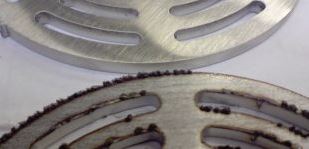
| Updated January 31, 2020This question has been asked enough in recent months that it might be worth exploring.
The best explanation might start with a story.
Many, many years ago we had an employee—we will call his name Frank for the purposes of this story—that was cleaning the metal drops, or remnants (the pieces left after cutting out specific shapes) from behind the shear (cutting machine).
(For those unfamiliar with fabrication think about cutting fabric with a pair of scissors…the scissors would be a shear of sorts and the pieces of fabric left outside the pattern would be the drop or remnants).
When a bunch of material is cut, there is often a large stack of remnants left behind the shear than need to be cleaned away. The material often falls into a scattered pattern and sometimes pieces get pinched or wedged into each other making it difficult to pull them out.
Frank was facing that exact situation. He was wearing gloves to protect his hands but one piece, on which he pulled, slid through his hand—the metal had a sharp edge from the shear cut. As the metal slid through his hands, it easily cut through his gloves and into his skin leaving him with a sever laceration that had to be stitched at the hospital.
The story illustrates how severe a burr can be on metal when it is sheared or saw cut. Those burrs, in many instances, are like razor blades. It happens when the shear blade or saw blade cuts through the metal and leaves a cut edge that is raised just-off the metal material.
Newer technology as decreased burrs. Laser cutting often leaves very little burr—but it does not eliminate it completely.
Many customers specifically call out burr removal on their part drawings.
At All Metals Fabrication, we have very concrete rules for deburring parts. We do not want our customers getting material that is sharp to handle.
Deburring can be accomplished by using sanding machines and tools. Most people are familiar with wood sanding (often to get rid of rough edges). The same applies to metal, although the equipment and sanding pads are quite different.
Deburring metal can be tricky, believe it or not. Too much deburring can lead to mis-configured parts. In addition, the wrong kind of deburring can eliminate the original burr only to add another burr.
Like any manufacturing, metal work has its own craftmanship rules. Eliminating burrs on metal may not compare to the craftmanship required to TIG weld or form metal parts just right, but, nevertheless, it is still and important element, as Frank might witness, to metal fabrication. It is a small detail that must be done right—and is worth the time and money to make sure it is right.
AMF has over 25 years of experience in the industry. We love to thrill our customers with accurate, burr free parts!